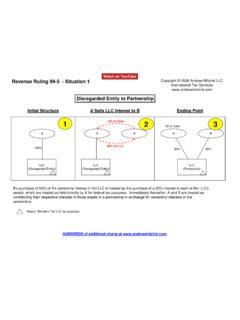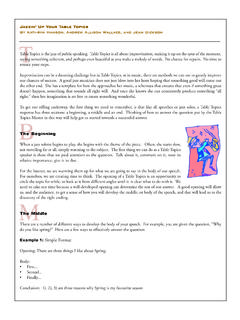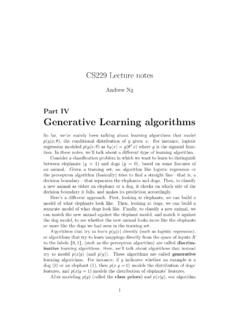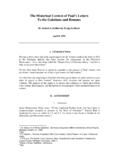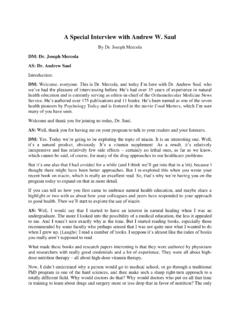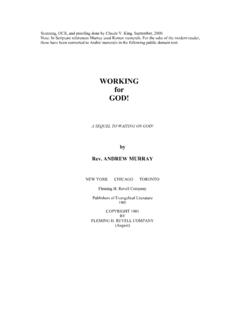Transcription of Music in the Renaissance – 1400-1600 - Andrew Lesser Music
1 Music in the Renaissance : 1400-1600 by Andrew Lesser , Leonardo, Raphael, Michelangelo, and Donatello. These are some of the names that come to mind when we think about the great masters of the Renaissance Age (not the Teenage Mutant Ninja Turtles!) Of course, the term Renaissance , or rebirth , is a relatively modern term, coined by the French historian Jules Michelet in the 19th century. Beginning in the Italian city of Florence near the end of the 14th century, the Renaissance Age is generally characterized as the reclamation of classical culture and a widespread development in art, Music , literature, science, and education. Great thinkers, inventors, and philosophers sought to understand the ways of nature and the universe, such as Leonardo da Vinci and Michelangelo Buonarroti. These men embodied the diverse and well rounded skills that would inspire the term Renaissance man.
2 In fact, even the term Middle Ages was designated as a transitional period between the age of Greek Classicism and the Renaissance (hence the word Middle ). Above all, the Renaissance would be defined by the concept of humanism, a way of learning that emphasized studying the ancient Greek texts and deriving new meaning from them by way of reasoning and research. Scholars and intellectual thinkers such as Niccol Machiavelli and Thomas More revived the ideas of the Greek and Roman philosophers, and applied them to contemporary settings. Writers such as Dante Alighieri and William Shakespeare devised new ways of understanding the human condition, and composers such as Josquin Desprez and John Dowland brought Music to the next stage of its evolution. For Music , however, the beginnings of what would be later defined as a style separate from the Middle Ages originated with the composers of England.
3 The English Sound ( Cheerio, Govn r! ) In the opening years of the 15th century, English Music in particular began to have a different sound than that of Music on the European continent. At the height of the Middle Ages, composers would strive to make each individual voice of a polyphonic composition be as independent as possible, which would sometimes sound complex and even very confusing. The English composers broke from this tradition by writing more homogeneous lines that promoted sonority above all else. Dissonances, if there were any, were very controlled in the style of chordal writing. In fact, such attention to providing consonances throughout a piece was called pan-consonant. The text also dictated the rhythm of the Music , with each line moving mostly together in a more vertical style than the individual horizontal lines of the Middle Ages.
4 The Music in the Renaissance 1400-1600 2 leading composer of this new style was John Dunstable (c. 1390-1453). Dunstable and his contemporaries inspired composers on the continent to write discant in the English style . Generally, aside from the pan-consonant method which the English sound was known for, Dunstable and his fellow composers also employed a technique known as faburden, derived from the practice of improvisation. Faburden consisted of the use of first inversion triads moving in parallel motion, of which the lowest voice was called the faburdener. The practice of writing parallel fifths and octaves was no longer tolerated. The largest manuscript that contains Music of the early 15th century is called the Old Hall Manuscript. Ironically enough, Dunstable s works are nowhere to be found, though the Music contained within the manuscript dates from 1370 to 1420, exactly during the height of Dunstable s popularity.
5 The picture on the right is a page from the Old Hall Manuscript containing a setting of the Gloria by Roy Henry (King Henry V). Other techniques that the English employed were taking the chant melody of the piece and putting it in the superius, or highest voice. Isorhythm was still a celebrated method of composition, and sometimes the chant melody would be found wandering from voice to voice, even manipulating it to the point where the theme was almost unrecognizable. Overall, it was the English method of writing that inspired composers all over Europe to elevate Music to the next course of its development. Humanism: The Face of the Renaissance Humanism, like the word Renaissance , was a term that was not brought into use until centuries later. For the people who lived in the Renaissance , they truly wished to separate their lives from the destruction and decadence of the Middle Ages, but they did not consider their age a rebirth of classical ideals.
6 In fact, works of the great Greek and Roman thinkers were still known to most people living in Italy, and there were even still Greek speakers living at the southern edge. Ancient texts were then reexamined, studied, and edited in the 15th century, but only according to the developing science for which the Renaissance was known for. While all the arts and sciences in Greek culture were thought to be interrelated, Renaissance humanists separated these concepts and studied them for their individual qualities. Music , in particular, was thought of as an expressive art to move the emotions and sway the senses, something that would have been unheard of during the Middle Ages. Thus humanism, developed in Italy, was a mass awakening to the ideals of Greek antiquity and the pursuit of studying and further developing those ideals.
7 Perhaps the most famous composer of the early 15th century in Italy was Johannes Ciconia. Born in Liege (now in modern-day Belgium), Ciconia was the son of a priest whose family was in high standing. As is typical with composers of the Medieval and early Renaissance period, we know very little of Ciconia s early life. We do know that he was studying in Rome in Music in the Renaissance 1400-1600 3 the 1390 s, and moved to Padua (northern Italy) after the turn of the century. In Padua, Ciconia became a cantor at the cathedral and eventually died there in 1412. Ciconia is primarily known for his uncanny ability to transition between the styles of the French Ars Nova and the new Italian style that would define his Music in his later life. In fact, his journey from the French low countries to northern Italy marked the beginning of a mass migration of composers to Italy. Ciconia s works are noted for their combination of the French contrapuntal style mixed with the Italian humanism that would define the spirit of the Renaissance .
8 His most famous work, the motet O Rosa Bella (O Beautiful Rose), anticipates the evolution of the humanistic approach to Music in which the Music must reflect the heightened emotional quality of the text. O Rosa Bella was an exceptionally popular tune in those days, and many composers set the poem to Music , including John Dunstable. No such approach of specifically crafting the Music to suit the emotional quality of the text was made during the Middle Ages, and it is this change in compositional style that is one of the largest differences between the Middle Ages and the Renaissance . The French Connection I m French! Where do you think I get this outrageous accent? - Monty Python and the Holy Grail While the secular Music of Italy and the Burgundian lands were constantly in a state of flux, the French formes fixes of the 1300-1500 s were still going strong. This is apparent in the works of the most famous composer of the mid-15th century, Guillaume Dufay.
9 Dufay (see Composer Profiles for biographical notes) was known for composing not only both sacred and secular works, but in every genre available at the time, including the ballade, the rondeau, and the virelai. The French chanson, or song with words , was now considered a secular song with the dominant theme of courtly love. As opposed to the chansons of the Middle Ages, however, chansons of the Renaissance quality involve painting the Music to the emotional quality of the words. Dufay, in particular, was a master in using elements such as mensuration, texture, counterpoint, and rhythm to heighten the quality of the poetry. Instrumental playing sometimes took part in accompanying the singers, and at times replacing certain voices if singers were not available. The harp was the most practiced instrument in the early 15th century until it was replaced by the more popular lute, ancestor of the modern day guitar.
10 Another great composer of the mid 15th century was Gilles Binchois (c. 1400-1460). Seen with the harp in the photo above, Binchois is seen having a pleasant discussion with Guillaume Dufay, seen with the portative organ on the left. Binchois served at the court of Philip the Good until his retirement in 1453. While usually mentioned together, Binchois s Music is quite different than Dufay s, though they both wrote in sacred and secular forms. Binchois was considered the Music in the Renaissance 1400-1600 4 finest melodist of his time, with many composers borrowing melodies from him in their own works. His works are much easier to follow than Dufay s both melodically and rhythmically. The Mass in the Renaissance One of the most important changes in sacred Music came with the new developments of the Mass in the 15th century. While the establishment of the triad as the basis for all polyphonic Music is the crowning achievement of the Renaissance in terms of style, then the cantus-firmus Mass is the achievement in terms of genre.

